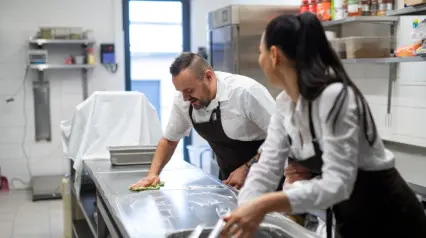What are Food Safety Guidelines?
Food safety guidelines are established protocols aimed at ensuring consumer health. It outlines the best practices for handling, preparing, and serving food to prevent or eliminate issues, such as bacterial or chemical contamination and ensuing foodborne illnesses or injuries. Food manufacturers, distributors, grocers, restaurants, and other businesses in the F&B or food and beverage industry should learn everything about these procedures as they protect not just their customers but also their reputation.
Significance
Basic food safety guidelines play a pivotal role in preserving the integrity of the food sector and protecting public health. Failure to adhere to these rules can result in several serious issues that endanger customer welfare and business sustainability. Here are some specifics:
- Prevents illnesses – Food safety should be a priority in the F&B sector as it protects consumers from potential health problems. Diseases like salmonellosis, typhoid fever, and hepatitis resulting from contamination are much too severe and could lead to fatal outcomes.
- Builds consumer trust – The general public expects safe and wholesome food products. Adherence to general food safety guidelines indicates a company’s commitment to its overall well-being. Ensuring food safety fosters not just trust but also brand loyalty.
- Legal and financial protection – Complying with CDC, USDA, and FDA food safety guidelines is not only required by law but also a wise business strategy. Eliminating contamination risks prevents expensive recalls, lawsuits from affected consumers, a significant decline in customers, and the loss of business.
The 10-Point Guideline for Safe Food Preparation
According to the World Health Organization, most foodborne illnesses are due to errors in food handling. Reducing the risk of pathogenic contamination is not too complicated, as evidenced by the following recommendations:
Go for Safely Processed Options
Processing is required for many food types to prolong their shelf life. It includes raw milk pasteurization, proper meatpacking, poultry irradiation, and seafood flash-freezing. Fresh produce, best consumed as is, only requires sufficient washing.
Cook Food Thoroughly
Raw foods like poultry, meat, and eggs carry pathogens like E. coli, Salmonella, and Listeria. The only way to kill these organisms is through heat. To ensure this, cooks should maintain a temperature of 70°C (158°F) in every part of the food before it comes off the stove or out of the oven.
Eat Cooked Meals Right Away
Microorganisms multiply when cooked dishes are permitted to cool to room temperature. The risk of pathogenic illnesses increases the longer it is exposed to this kind of environment.
Carefully Store Fresh Produce and Cooked Meals
Leftovers may be kept in the refrigerator for five to six hours at 10°C (50°F) or less because bacterial proliferation halts in colder temperatures. Dishes prepared in advance, often done in cafeterias, should be stored under 60°C (140°F). Preserving foods via canning or jarring is used by a lot of food manufacturers. Based on canned food safety guidelines, the right temperature for these processes is 250°C (250°F).
Reheat Dishes Properly
After storage, reheat cooked foods to 70°C (158°F). Aside from making the dish palatable again, this slows down any microbial growth that may have developed while in the fridge.
Avoid Contact Between Cooked and Raw Foods
Cross-contamination quickly happens when raw food like poultry touches cooked meals. And it could come about most subtly, like slicing a chicken breast on a chopping board and using the same kitchen utensils on oven-baked roast beef.
One of the most critical food safety guidelines regarding cross-contamination is the risk of allergic reactions. Part of good manufacturing practice is ensuring that there will be no allergens (e.g., peanuts, eggs, and shellfish) near their products because the tiniest amount could cause swelling, cramps, and airway issues for hypersensitive individuals.
Constantly Wash Your Hands
Maintaining good personal hygiene is the foundation of food safety. Handwashing is the simplest habit to adopt, done before and after food preparation and in between handling different kinds of food. Wearing the proper PPE (Personal Protective Equipment) is also vital when working with food.
Meticulously Clean All Kitchen Surfaces
The tiniest dripping spot, breadcrumb, or towel lint is a potential reservoir of pathogens., Because of these threats, surfaces used for food preparation must be kept sterile, according to food and safety sanitation guidelines. Using non-toxic cleaning products is also a must since these could taint the meals.
Keep Insects Away from Food
Flies, cockroaches, and ants can transmit disease-causing bacteria, fungi, and viruses. The best way to prevent them from doing so is by storing food, both raw and cooked, in closed containers.
Use Safe Water
Water is essential in food preparation and used for cleaning, sanitation, and as a cooking ingredient. Everyone in the food and beverage industry and those at home should ascertain that the water used for these processes is free from impurities. If there are doubts about the supply, boiling it (up to 100°C or 212°F) removes those.
Effective Implementation of Food Safety Procedures
The guidelines are simple, easy to understand, and follow. Homemakers habitually practice this, being the primary caregivers of their families. However, setting these standards in a company may be more challenging. Here are ways to ensure its effective implementation.
- Conduct regular inspections and audits – Consistency is vital in the food industry. The only way to ensure this is by conducting inspections in all work areas, including restaurant pantries and kitchens, warehouse facilities, manufacturing lines, and many more. Employees should be constantly observed and interviewed to gauge their understanding of food safety procedures.
- Leverage the HACCP (Hazard Analysis Critical Control Point) System – This preventive methodology is used to identify, evaluate, and manage food safety hazards. It helps companies conduct hazard analysis so they can establish corrective actions and preventive remedies.
- Provide continuous education and training – Agricultural workers, kitchen staff, and all food handlers should understand and adhere to food safety protocols. Forming good habits is possible when workers are given extensive training on personal hygiene, cross-contamination prevention, temperature controls, and many others.
Food Safety Laws and Regulations
Food safety regulations ensure that businesses uphold the health and safety of consumers at every step of their operations. Get to know the agencies directly responsible for administering these guidelines:
United States
The law governing food safety in the USA is the Food Safety Modernization Act. From this, various departments have established specific rules and recommendations. The United States Department of Agriculture (USDA) food safety guidelines focus on policy creation and inspection. The Center for Disease Control (CDC) food safety guidelines deal with investigations on foodborne infections.
United Kingdom
In the UK, the Food Safety Act of 1990 is the umbrella legislation that empowers the Food Standards Agency (FSA) and local authorities to create policies and enforce regulations about handling, labeling, transportation, and recall.
Australia
Food Standards Australia New Zealand (FSANZ) sets the standards on ingredient and additive use, processing methods, and food transportation. The FSANZ Act of 1991 governs these regulations.
The organization has recently released an update on Standard 3.2.2A, where businesses in food services, caterers, and related retailers must follow two or three more requirements to ensure compliance with food safety standards.
European Union
European Food Safety Authority (EFSA) operates under the General Food Law Regulation as its foundation. They provide scientific recommendations and disseminate critical information about the risks in this sector while the member states enforce the regulations.




